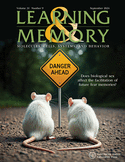The need for novel informatics tools for integrating and planning research in molecular and cellular cognition
- 1Department of Neurobiology, Department of Psychiatry, Department of Psychology, Integrative Center for Learning and Memory, Brain Research Institute, University of California at Los Angeles, Los Angeles, California 90095-1761, USA
- 2Machine Learning Group, Technische Universität Berlin, 10587, Berlin, Germany
- 3Berlin Center for Big Data and Department of Brain and Cognitive Engineering, Korea University, Seoul, 136-701 Korea
- Corresponding author: silvaa{at}mednet.ucla.edu
Abstract
The sheer volume and complexity of publications in the biological sciences are straining traditional approaches to research planning. Nowhere is this problem more serious than in molecular and cellular cognition, since in this neuroscience field, researchers routinely use approaches and information from a variety of areas in neuroscience and other biology fields. Additionally, the multilevel integration process characteristic of this field involves the establishment of experimental connections between molecular, electrophysiological, behavioral, and even cognitive data. This multidisciplinary integration process requires strategies and approaches that originate in several different fields, which greatly increases the complexity and demands of this process. Although causal assertions, where phenomenon A is thought to contribute or relate to B, are at the center of this integration process and key to research in biology, there are currently no tools to help scientists keep track of the increasingly more complex network of causal connections they use when making research decisions. Here, we propose the development of semiautomated graphical and interactive tools to help neuroscientists and other biologists, including those working in molecular and cellular cognition, to track, map, and weight causal evidence in research papers. There is a great need for a concerted effort by biologists, computer scientists, and funding institutions to develop maps of causal information that would aid in integration of research findings and in experiment planning.
Footnotes
-
Article is online at http://www.learnmem.org/cgi/doi/10.1101/lm.029355.112.
- Received March 31, 2015.
- Accepted July 9, 2015.
This article is distributed exclusively by Cold Spring Harbor Laboratory Press for the first 12 months after the full-issue publication date (see http://learnmem.cshlp.org/site/misc/terms.xhtml). After 12 months, it is available under a Creative Commons License (Attribution-NonCommercial 4.0 International), as described at http://creativecommons.org/licenses/by-nc/4.0/.










